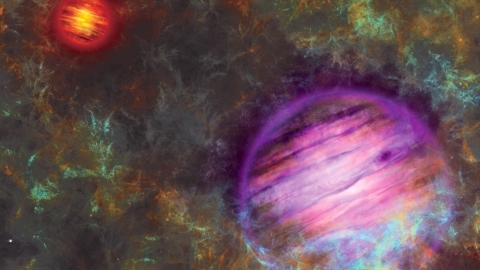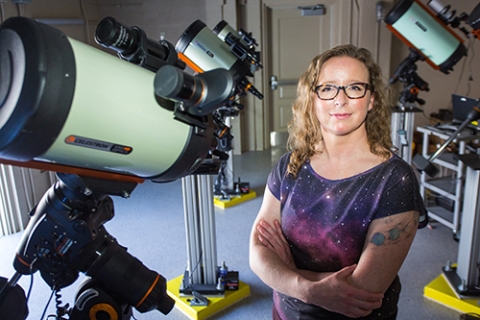
Bucknell Astronomers Discover Binary Planetary System
January 21, 2021
An artist's composition of the two brown dwarfs — Oph 98B in purple in the foreground and Oph 98A in red in the background. Rendering by Thibaut Roger
Using NASA's Hubble Space Telescope, Bucknell physics & astronomy Professor Katelyn Allers and postdoctoral researcher Blake Pantoja have observed an astronomical anomaly few have encountered before. They were part of an international research team that has discovered a new binary planetary system 450 light-years away from Earth composed of two brown dwarfs of differing masses orbiting around each other from a strikingly wide distance.
Discovery of the system, named Oph 98, was made in the young Ophiuchus star-forming region and is a unique example of a binary system detected right after birth. Star-forming processes sometimes create astronomical objects called brown dwarfs, which are smaller and colder than stars. Just like stars, brown dwarfs often wander alone through space, but can also be seen in binary systems, where two brown dwarfs orbit one another and travel together in the galaxy.

Blake Pantoja, postdoctoral researcher, physics & astronomy
"It's rare that we're able to see a binary set of objects, and especially ones at planetary masses, right at the time of their formation," Pantoja says. "This system is only a few million years in the making and so it has not had a lot of time to form into what they are as we see right now. It really can make for a benchmark on our understanding of the formation of brown dwarfs and those in binary pairings."
The research team, which included researchers from the Center for Space and Habitability and NCCR PlanetS at the University of Bern (Switzerland), published a study on their discovery last month in The Astrophysical Journal Letters, a leading astronomical journal.
In the paper, the researchers noted their surprise by the fact that Oph 98 A and B are orbiting each other from such a large distance — about 200 times the distance between the Earth and the sun. In addition to its young age, Oph 98 is also distinct from other binary systems because of its low masses.
"What is really interesting about this is that it gives us some first-hand information on the formation of planetary mass objects, and because they're so widely separated, we actually would expect these binary companions to form in a more star-like fashion," Pantoja says.
Allers adds, "Another interesting thing about this system is that the gravitational force holding these widely-separated, low mass objects together is extremely weak. We expect that this system will be easily disrupted as it continues to evolve."

Professor Katelyn Allers, physics & astronomy. Photo by Brett Simpson Photography
In order to make the discovery, Allers was the principal investigator on a 2013 grant proposal to obtain both observing time on the Hubble Space Telescope and research funding from NASA. That proposal required an outline of all of the technical specifications for the use of Hubble in the project.
"Hubble is all-automated and this process is really time consuming," Allers says. "What you do is essentially write the script that's going to be sent up to Hubble to tell it how to take your observations. So it has to be perfect — every aspect from how it's going to move to your object, how long it's going to stare at the object, and what types of pictures it's going to take. You have to be very specific."
According to Allers, Hubble orbits the Earth every 97 minutes and as a result, it can't remain continuously fixed on a specific object in space.
"You can observe it for multiple hours, but you'll always lose the object due to gaps when the Earth blocks the object from Hubble's view during the orbit," she says. "When you're awarded time on Hubble, you're actually awarded a certain number of orbits. We were awarded 30 for the program overall. All of the data for Oph 98 was taken during one orbit."
Because binary systems like this are very rare, the researchers looked at some 30 different objects with Hubble before finding the companion to Oph 98. Confirming that the companion is actually associated with Oph 98 is the important next step, according to Allers.
"The complicated thing with this is that you can see an object that may be next to your target star or brown dwarf, but what's really tricky is confirming that the companion is actually associated with it and not just some distant star that falls next to it randomly in the sky," she says. "That's where proper motion — where you make sure they're moving together across the sky — is really important."
The Bucknell researchers have now been awarded time on the Gemini Observatory in Hawaii to continue their research on the Oph 98 system. They plan to gather information on both the atmospheric composition of the two planetary mass objects, as well as their formation mechanism.
